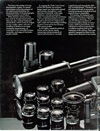

Extending the Limits of Lens Performance
The lens is the nucleus of every photographic system. Its optical performance is the first measure of all cameras and establishes the theoretical limits of the photographs which the system can produce.
While the first criterion of any lens must be its optical performance, there are also various functional standards by which it may be judged. Its size, weight, speed, and ease of handling in relation to its image producing characteristics, all contribute to the total effectiveness, versatility, and range of the photographic system.
In creating the Zuiko Lens Group of the OM System, our primary design target was impeccable optical performance throughout a wide of selection of standard, wide angle, telephoto, and special purpose lenses. Complementing this ambitious goal was the determination to equal the great advances in compactness, light weight and outstanding handling qualities achieved by the Olympus OM camera bodies.
In the highly competitive field of 35mm camera lenses, merely surpassing existing standards of optical performance is, by itself, a significant and remarkably difficult accomplishment. Therefore, or self-appointed task of surpassing existing functional standards as well, seemed close to impossible.
Fortunately, the designers and engineers at Olympus could draw on impressive resources. The first was the Olympus tradition of pioneering optical design in microscopes, medical instruments, and industrial as well as camera lenses: a tradition reaching back to the beginning of the century. Next were superbly equipped facilities for the design and evaluation of new lenses, and for the development of superior optical glasses. These facilities included computers to design lens models and assess their performance by Image Evaluating Simulation using Modulation Transfer Function.
Other facilities and techniques greatly increased the scope of the research while obviating many expensive and time-consuming trial-and-error procedures, bringing the final designs close to the theoretical optimum.
Last, but not least, was the skill and dedication of the large research staff itself, allowed full rein by the generously funded, unrestricted development program.
The current lenses of the OM System vindicate Olympus’ commitment to uncompromisingly high standards. Encompassing everything from fisheyes to super telephotos and a number of completely original special purpose lenses, they are, without exception, astonishingly light and compact. All are unusually quick and easy to use, and all but a few special purpose lenses feature fully automatic diaphragm with open aperture viewing. Many also offer extreme brightness; for example, the 24mm F2 is the first lens of this speed in its focal length.
The lenses introduced in this brochure are not merely superb optical instruments; they are in every respect worthy of their central role in the remarkable Olympus OM System.
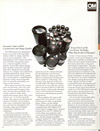

Dramatic Gains in Both Compactness and Image Quality
The OM System was designed to bring every kind of photographic subject within its range, from the stars to microorganisms. This demanded not only superb precision and reliability, but equally quick, easy, positive handling characteristics. In the OM camera bodies, these qualities stem from radically innovative design that drastically reduces size, weight, noise and shock, yet keeps generously-sized, rationally-located controls. In the system, they are assured by a comprehensive selection of fully interchangeable units as versatile and quality conscious as the cameras.
Most important of all the system units are the lenses. Not only must they produce superb images, they must also function faultlessly with a huge variety of other units: among them motor drive, flash, auto bellows, etc. To do this most efficiently, they feature standardization wherever possible, for example in filter sizes; consistently high sharpness and contrast throughout the focusing range; and maximum compactness, lightness and brightness.
Naturally, to achieve uncompromising performance involved compromises between certain absolute laws of physics. Ultimately extra lens brightness, for instance, can only be gained at a cost in compactness, because the F-number is a direct expression of the relation between the lens diameter and the focal length. However, there is another physical relationship Olympus was able to exploit to advantage. The diameter also depends on the lens’ overall length. By improved design and the use of more efficient optical glass it became possible to make the lenses shorter, reducing the diameter closer to the theoretical minimum, and in turn contributing to greater compactness.
One example is the super wide angle 21mm F3.5 which is about half the size of other comparable lenses. Others are the 16mm F3.5 fisheye which is smaller than a standard lens, the 100mm F2.8 which looks no bigger than a normal standard lens, the 75~150mm F4 zoom whose size compares with a conventional 135mm fixed focus lens, and the almost incredibly compact 200mm F5. Taken together, the OM System lenses can reduce the cameraman’s burden by kilograms, great for location photography!
If Lens Size Can Be Cut Down So Easily, Why Was It Left to Olympus?
In fact, it was not easy. Unfortunately, reducing the length of a lens aggravates a number of problems connected with spherical aberration, chromatic aberration, coma and other kinds of aberration. The solution of these problems was arduous, demanding infinite patience and experimentation in addition to the full scale adoption of computerized design techniques. In many cases it was necessary to evolve completely new designs, testing them scrupulously against the best of other comparable lenses and against each other. Frequently, it was decided to scrap prototype lenses that did not match up to the OM System size and performance specifications even though they were better than any other lenses in their class.
For every lens the greatest attention was paid to uniformity of resolution and contrast across the lens, at all apertures and focusing distances. In several lenses a group of independent elements was incorporated to insure automatic correction in close focusing. Many large diameter wide angle lenses were specially multi-coated to minimize flare from reflected light.
Every one of the OM System lenses that eventually saw the light of day is a masterpiece of functionality and optical performance.
FISHEYE LENSES
Giving a full 180 degree angle of coverage, this type of lens was first developed to allow astronomers and meteorologists to photograph the entire sky. Today, fisheye lenses are commonly used in a wide range of scientific, industrial and research applications, while their fascinating distortion characteristics also make them an exciting tool for creative photographers.
Fisheye lenses have a similar construction to retrofocus type lenses. The light reaching the lens is first refracted into a cone by the concave front element, then formed into a circular image by the convex rear element. The distortion of the fisheye lens is essential to contain the image in a given area – without it the image on a flat plane would in theory be infinitely large. In both the Zuiko Fisheye Lenses the distortion depends on the equisolid angle projection, a boon for scientific applications because this formula allows easy calculation of the cubic angle of the image.
The Zuiko Fisheye 8mm F2.8 is a pure fisheye, projecting a 23mm diameter circular image on the film. The Zuiko Fisheye 16mm F3.5, on the other hand, produces an image that covers the entire frame by cropping a 44mm diameter circular image.
ZUIKO
FISHEYE 8 MM F2.8
WEIGHT/640g (22.6oz.)
LENGTH/82mm (3.3in.)
Despite its high speed, the lens is extremely compact and features an automatic diaphragm permitting precise, full aperture composition. If focuses down to 0.2m (7.9"). There are four built-in filters (L39, Y48 O56, R60).
ZUIKO
FISHEYE 16mm F3.5
WEIGHT/180g (6.3oz.)
LENGTH/31mm (1.2in.)
A fully automatic fisheye with high resolution and contrast that gives an image covering the whole film area. The innovative optical design incorporates a positive element in the second group to cut down chromatic aberration, improve definition, and allow shorter overall lens length. There are three built-in filters (L39, Y48, O56).


SUPER WIDE ANGLE LENSES
These are the lenses to use for dramatic landscapes and sweeping interior shots. Because of their intensified perspective effects they also serve to bring out interesting new angles in portraits and group photos, etc. In addition their great depth of field can be very helpful in action close-ups when there is not time for pinpoint focusing.
More and more photographers are attracted by the creative possibilities of super wide angle lenses, and the trend is to shorter focal lengths and higher lens speeds.
The three Zuiko lenses in this group play their part by assuring superb image quality and unusual brightness in an astonishingly compact, lightweight format.
ZUIKO
MC 18mm F3.5
WEIGHT/250g (8.8oz)
LENGTH/42mm (1.7in.)
The widest of the OM super wide angle lenses, with a 100degree angle of view for dramatic, yet distortion-free, perspective effects. All 11 elements in 9 groups are multi-coated to minimize flare. Floating elements eliminate close focus aberrations.
ZUIKO
MC 21mm F2
WEIGHT/250g (8.8oz.)
LENGTH/43.5mm (1.7in.)
A pioneering lens with built-in floating element system. Although it is the world’s first F2 lens in this focal length, it overcomes inherent aberration and other problems highly satisfactorily, as well as minimizing image fall-off at close distances. Ideally suited for low available light interiors, etc.
ZUIKO
21mm F3.5
WEIGHT/180g (6.3oz.)
LENGTH/31mm (1.2in.)
A remarkably small and bright lens with seven elements in seven groups construction. Resolution and contrast are excellent even at full aperture, and special consideration was given to compensating aberrations to guarantee superb close-up characteristics.
ZUIKO
MC 24mm F2
WEIGHT/280g (9.8oz.)
LENGTH/48mm (1.9in.)
With the fastest speed available in this focal length, the 24mm F2 is perfect for low light interior photography. The highly advanced design features a group of elements for automatic correction of close-up aberration, and newly introduced optical glass of outstanding performance.
ZUIKO
24mm F2.8
WEIGHT/180g (6.3oz.)
LENGTH/31mm (1.2in.)
Even more compact than the 24mm F2, this lens affords the same fantastic image quality throughout the focusing range. The 24mm focal length gives the benefit of exaggerated perspective that is relatively easy to handle, without demanding excessive care in composition.
Wide Angle Lenses
Lenses in this group offer an attractive compromise between the panoramic sweep of the super wide angles, and the more normal but restricted perception of standard lenses. They produce pictures that are natural to look at, yet take in significantly more than lenses in the 50~55mm focal length range. At the same time their generous depth of field makes them fast and adaptable enough to cope with almost any kind of subject. Indeed they are so versatile many photographers use them in preference to normal standard lenses.
Zuiko wide angle lenses provide a choice between the extra high speed of F2 and the extreme lightness and compactness of somewhat slower formats, in both 28mm and 35mm focal lengths.
ZUIKO
MC 28mm F2
WEIGHT/250g (8.8oz.)
LENGTH/43mm (1.6in.)
A compact retrofocus type lens featuring exceptional resolution and contrast, and compensation for close focusing aberrations by way of a special correction group. Excellent for night and indoor photography.
ZUIKO
28mm F3.5
WEIGHT/180g(6.3oz.)
LENGTH/31mm(1.2in.)
The smallest and lightest 28mm retrofocus type lens available anywhere, yet offering first class resolution and ample marginal illumination. The 75 degree angle of view is wide enough for the great majority of subjects, not too wide to make composition tricky.
ZUIKO
MC 35mm F2
WEIGHT/240g (8.5oz.)
LENGTH/42mm (1.7in.)
Thanks to innovative mechanical and optical design this lens sets new standards of performance and compactness in this highly popular format. Definition is superb, and the high speed enables the photographer to handle poorly lit subjects with confidence.
ZUIKO
35mm F2.8
WEIGHT/180g (6.3oz.)
LENGTH/33mm (1.3in.)
The loss of an F-stop allows a further reduction in weight and size, while the special construction of seven elements in six groups results in minimal comatic flare. An excellent general purpose lens for groups, outdoor scenes, etc.
ZUIKO
SHIFT 35mm F2.8
WEIGHT/310g (10.9oz.)
LENGTH/58mm (2.3in.)
Providing both vertical and lateral shifting function, this unique lens is ideal for architectural, studio and composite panoramic photography. Aligning the subject parallel to the film plane and composing with the shift mechanism insures correct linear and angular reproduction. The total angle of coverage is the same as with a normal 24mm lens.
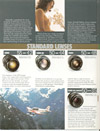
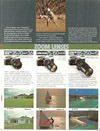
STANDARD LENSES
Generally considered the most versatile of all lenses, because their angle of vision approximates to the angle within which the human eye can discern colors and shapes clearly, standard lenses have the additional advantage of extremely high speed. This not only makes them the finest choice for available light photography, but insures the brightest possible image for positive composition and focusing in all situations.
Three of the four Zuiko standard lenses in the Olympus OM System, the 55mm F1.2, the 50mm F1.4 and the 50mm F1.8, perform more or less as conventional top quality standard lenses, though lighter, more compact, and with a very useful 0.45m minimum focusing distance. The fourth, the Zuiko Macro 50mm F3.5, has a slower speed but focuses all the way down to 0.23m(9.1") for a maximum 1:2 image reproduction. It features remarkable resolution and tone rendition throughout the focusing range, with automatic correction of close focusing aberrations.
ZUIKO
55mm F1.2
WEIGHT/310g (10.9oz.)
LENGTH/47mm (1.9in.)
The brightest of the OM System lenses, with impeccable resolving power right to the edge of the picture. In the distinctive seven element, six group construction, the fourth group act as a concave with the cemented surface facing the object, to correct aberrations.
ZUIKO
MC 50mm F1.4
WEIGHT/230g (8.1oz.)
LENGTH/39mm (1.5in.)
Another seven elements in six groups design that produces outstanding resolution and contrast over the whole picture area even at full aperture. Total length of this lens is a mere 39mm.
ZUIKO
50mm F1.8
WEIGHT/170g (6.0oz.)
LENGTH/31mm (1.2in.)
Superb edge-to-edge sharpness throughout the focusing range, and extreme compactness make this lens ideal for all but the most obscure photographic subjects.
ZUIKO
MC MACRO 50mm F3.5
WEIGHT/200g (7.1oz.)
LENGTH/40mm (1.6in.)
Primarily designed for close-up and copying work, and macrophotography, the Macro 50mm incorporates a number of innovative features such as compact configuration without excessive elongation of the lens barrel at close focusing distances, the first ever automatic correction lens group to be built into a macro lens, etc. Used with the Extension Tube 25 unit, it gives fine image reproduction between 1:2 and life size.
ZOOM LENSES
Zoom lenses have benefited enormously from recent advances in optical theory and lens design, and the development of more sophisticated optical glass. As a result modern zoom lens performance is, or should be, on a level with that of top quality fixed focus lenses, while drastic reductions in size and weight have become practicable.
These improvements make the zoom, with its unlimited choice of focal lengths within a given range, an attractive proposition for perfectionists and professionals. Its advantages are obvious to all those people who prefer to compose their picture by flicking a dial, rather than establishing the best lens-to-subject distance by a time and energy consuming process of trial and error.
ZUIKO
MC ZOOM 35-70mm F3.6
WEIGHT/400g (14.1oz.)
LENGTH/74mm (2.9in.)
With a weight of only 400g (14.1oz) and a minimum length of just 74mm (2.9in.), this fast F3.6 zoom is ideal for all kinds of general photography in the moderate wide angle to moderate telephoto range. Resolution and contrast are up to fixed-focus lens standards. The rubber hood can be reversed for easy storage.
ZUIKO
ZOOM 75-150mm F4
WEIGHT/440g (15.5oz.)
LENGTH/115mm (4.6in.)
An extraordinarily functional and versatile lens fully covering the short-to-medium telephoto range, with a very compact format and a weight less than many fixed focus medium telephotos. This lens is superb for portraits, landscapes and sports, as well as general and special effects photography.
ZUIKO
MC ZOOM 85-250mm F5
WEIGHT/890g (31.4oz.)
LENGTH/196mm (7.7in.)
Exceptionally compact for its range, yet guaranteeing superb quality up to fixed focus lens standards. As with all OM System zoom lenses, focus remains correct throughout the zoom range. The lens has a detachable tripod ring, and a built-in retractable hood.
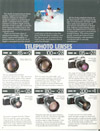
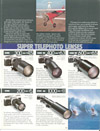
TELEPHOTO LENSES
For closely framed portrait photography, magnification of distant subjects, picking out attractive landscape patterns or architectural details, a telephoto lens is needed. Owing to its shallow depth of field, this type of lens is equally invaluable for bringing the subject clearly into focus against a blurred background or foreground.
There are two basics types of telephoto lens design – the "long focus", constructed similarly to standard lenses, in which the focal length is measured from the second nodal point of the lens to the film plane with the focus at infinity; and the "short barrel" in which the lens itself is made much shorter than its actual focal length.
All the Zuiko telephoto lenses are of "short barrel" construction for the sake of compactness and light weight. They make such ingenious use of new optical and mechanical designs that, without compromising performance, the 100mm lens for example, is comparable in size to conventional standard lenses. This achievement greatly extends the limits of handheld photography, and represents a breakthrough in carrying convenience.
ZUIKO
MC 85mm F2
WEIGHT/260g (9.2oz.)
LENGTH/46mm (1.8in.)
The fast speed of this medium telephoto is ideal for low light situations, positive focusing, and to create interesting out-of-focus effects in portraiture, etc. Automatic correction mechanism insures top quality close-up rendition for tightly framed faces, still life pictures, plants and other subjects.
ZUIKO
100mm F2.8
WEIGHT/230g (8.1oz.)
LENGTH/48mm (1.9in.)
With the same size and weight, and the same high resolution and contrast as a standard lens, the 100mm F2.8 produces an image twice as large. The longer perspective assures undistorted portraits and superb medium telephoto shots.
ZUIKO
MC 135mm F2.8
WEIGHT/360g (12.7oz.)
LENGTH/80mm (3.2in.)
The angle of view of the 135mm focal length lens corresponds roughly to the angle of acute human vision, making this the shortest lens to give a pronounced telephoto effect. The five elements in five groups construction of the fast 135mm F2.8 guarantees edge-to edge picture sharpness. An extremely compact and versatile lens.
ZUIKO
135mm F3.5
WEIGHT/290g (10.2oz.)
LENGTH/73mm (2.9in.)
Even more compact than the 135mm F2.8, but with the same outstanding image quality, thanks to the unusually sophisticated five element construction. Both of the Zuiko 135mm lenses feature built-in retractable lens hoods.
ZUIKO
MC 180mm F2.8
WEIGHT/700g (24.7oz.)
LENGTH/124mm(4.9in.)
Designed especially for use in theatres, indoor arenas, etc; this lens is unusually fast but remarkably compact, with excellent edge-to-edge sharpness. Color rendition, contrast and resolution are outstanding even at maximum apertures. A retractable lens hood is built in.
ZUIKO
MC 200mm F4
WEIGHT/510g (17.9oz.)
LENGTH/127mm (5.0in.)
A relatively fast lens that is quite small and light enough for hand-held photography at medium shutter speeds. The resolution and 4X image magnification of this lens make it perfect for candid portraits, landscapes and animal photography.
ZUIKO
200mm F5
WEIGHT/380g (13.4oz.)
LENGTH/105mm (4.2in.)
At 105mm astonishingly short for its focal length, and with a remarkable six elements in five groups optical configuration, the 200mm F5 gives uniformly excellent picture sharpness right down to the minimum focusing distance. Like the 200mm F4 it has a built-in retractable lens hood.
SUPER TELEPHOTO LENSES
At the other extreme from fisheyes and super wide angles, the lenses in the super telephoto group also provide dramatic picture effects. In this case it is due to the drastic foreshortening of space relationships in the narrow angle of view.
However, the use of super telephoto lenses is far from limited to special effects photography. They are essential in situations where it is dangerous or impossible to approach the subject closely. Sports and wildlife photography are good examples, but these lenses also have many applications in astronomical and scientific photography.
Olympus has made every effort to minimize their unavoidable bulkiness and weight, and both the 300mm F4.5 and the 400mm F6.3 can be hand held. Although the 600mm and 1,000mm lenses are also comparatively small for their focal lengths they give better results when mounted on a tripod. All the lenses in this group are equipped with built-in retractable lens hoods.
ZUIKO
300mm F4.5
WEIGHT/1100g (38.8oz.)
LENGTH/181mm (7.2in.)
Incorporating newly developed optical glass for improved resolution and minimal chromatic aberration, this lens is sufficiently light and compact for convenient hand-held sports, wildlife and mountain photography. The tripod mount ring can be removed when not required.
ZUIKO
MC 400mm F6.3
WEIGHT/1300g (46.0oz.)
LENGTH/255mm (10.1in.)
Specially designed for fast hand-held shooting, and an invaluable addition to the equipment of the sports photographer, photojournalist and outdoor photography enthusiast, the 400mm F6.3 handles with the same facility as lenses for shorter focal lengths. The tripod mount ring is removable.
ZUIKO
MC 600mm F6.5
WEIGHT/2800g (98.8oz.)
LENGTH/377mm (15.0in.)
Unusually compact, with an unprecedented telephoto ratio of 0.7, the 600mm F6.5 provides superb image quality from infinity to the 11m minimum focusing distance. The 12X image magnification makes for truly dramatic effects.
ZUIKO
MC 1000mm F11
WEIGHT/4000g (141.0oz.)
LENGTH/662mm (26.3in.)
The front component in the five elements in five groups lens configuration consists of apochromatic type elements for superior definition and contrast with minimum chromatic aberration. As with all but a few special purpose lenses in the OM System, the diaphragm is fully automatic.
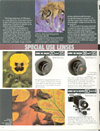

SPECIAL USE LENSES
The long experience of Olympus as a manufacturer of precision microscopes and optical measuring instruments pays valuable dividends in the field of macrophotography.
Normal lenses are designed to deliver their best performance at a specific focusing distance, usually infinity, but they will give perfectly acceptable results up to distances as close as maybe one meter from the film plane. However, at still closer distances, and higher magnifications, their resolving power decreases rapidly.
Standard macro lenses extend the capability for high resolution close-up photography considerably, giving optimum performance at reproductions of around 1:10. Yet they reach their limits when the photographic image reaches life size or beyond.
At this point it becomes necessary to resort to more specialized lenses, such as the three special macro lenses available in the OM System. These lenses are designed specifically for use with the OM System Auto Bellows, and each provides optimum performance at a different range of magnifications.
ZUIKO
MC MACRO 20mm F3.5
WEIGHT/70g (2.5oz.)
LENGTH/20mm(0.8in.)
Designed for magnifications of 4.3X to 12X used in conjunction with the Auto Bellows, the lens gives unique performance at the limits of macrophotography.
ZUIKO
MC MACRO 38mm F3.5
WEIGHT/90g (3.2oz.)
LENGTH/28mm (1.1in.)
Covering a magnification range of 1.8X to 6X, the Macro 38mm offers the highest possible resolution in macrophotography, recopying and close-up work. Like the Macro 20mm, it is attached to the Auto Bellows with the Objective Lens Mount PM-MTob.
ZUIKO
MC 1:1 MACRO 80mm F4
WEIGHT/200g(7.1oz.)
LENGTH/46mm (1.8in.)
Achieving resolution and contrast standards higher than any other lens of its type, this lens provide images of outstanding quality at all magnifications between 1/2X and 2X.
THE OTHER OM SYSTEM GROUPS
FINDER GROUP
A choice of 14 focusing screens, interchanged quickly and easily through the lens mount. To match the comprehensive range of OM System lenses and other units, they assure optimum viewing in every conceivable situation, from normal photography to super telephotography, bellows photography, photomicrography, etc. Even better picture control is assured by the other Finder Group units, which include the unique Varimagni Finder for image magnification of 1.2 or 2.5 times, the Eyecup 1, and a series of dioptric correction lenses from +2 to –5 dip.
MOTOR DRIVE GROUP
Fantastically small and light, but with the highest performance, reliability and versatility. The units are ideally balanced for hand-held photography, yet they feature a remarkable maximum speed of five frames per second with normal through-the-lens viewing, and operate at any shutter speed.
FLASHPHOTO GROUP
Pioneering fully automatic Centralized Control Flash with the T32 and T20 (with the OM-2), and featuring both flash charge and correct flash exposure indications in all OM camera viewfinders. A high power modular flash with a full range of system units including the Power Bounce Grip 2 gives full professional performance and versatility.
MACROPHOTO GROUP
A huge range of units for close-up and macro photography. Among them: Auto Bellows, copy stands, illuminators, close-up lenses, etc., etc.
PHOTOMICRO GROUP
Designed to make the OM System fully adaptable for microscope work. Epi-illuminators, automatic and manual exposures bodies, stands, adapters and many other units are available.
PHOTOTECHNICAL GROUP
With the cordless, automatic quartz watch type Recordata Back 3 for time and date imprinting, the Recordata Back 2 for various coded data, and a variety of adapters for astrophotography and other highly specialized applications.
CASE GROUP
A complete range of camera and lens cases, camera bags, straps, etc. to afford maximum protection and instant readiness.
Zuiko Interchangeable Lens Group
C14E-280D
ZUIKO LENS CATALOG - 1, 2